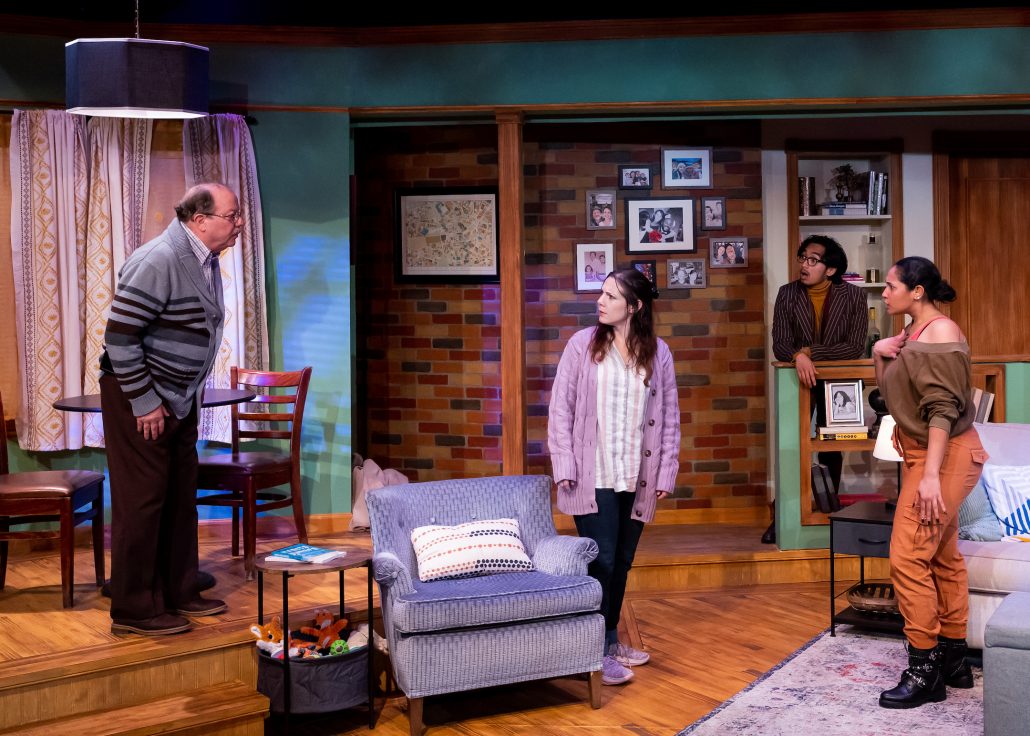In Theatre Lab’s apocalyptic comedy “Last Night in Inwood,” the end of the world is an ambient, nebulous thing. It’s less the singular shock of a nuclear bomb or asteroid collision than the cumulative effects of climate change finally washing up on our doorsteps.
Through scraps of information delivered by the play’s characters and the snippets of radio and TV news they absorb, we learn of flooding, fires and looting, of government services suspended and domestic pets turning feral, of military roundups and concentration camps. Danny (Aubrey Elson), the young woman whose fifth-floor Manhattan apartment is the play’s setting, opens the show wearing a face mask, alone, at home—perhaps a lingering holdover from three years’ worth of coronaviral droplets, or a harbinger of some new nastiness spreading in the ether. I half-expected the “airborne toxic event” from “White Noise” to make a cameo.
The thing about apocalypses is, like weddings and Thanksgivings, they do tend to bring families and friends together. For “Last Night in Inwood,” that means Danny’s father, Max (Avi Hoffman); her aunt, Sheila (Patti Gardner); Danny’s husband, Cal (Jovon Jacobs); and her neighbors, Jazz (Lynette Adames) and Billy (Paolo Pineda); will all be sheltering in place in her one-bedroom apartment. Against this backdrop of impending doom—the second act, with its dim lighting, takes place entirely after the power has been lost, presumably forever—the characters will scrape open long-dormant wounds, reveal painful secrets and, most improbably in a time of cataclysm, riff on the sociopolitical issues of the moment. It’s Sartre’s “No Exit” updated for a divided 21st-century America.

I wanted to love this show. I really did. Apocalypses are my jam. But in the script, written by Alix Sobler, this backdrop is a story device—a programmatic conceit to get a bunch of people of sundry persuasions mixing it up in a room—rather than a drama to be mined for all of its harrowing potential.
The characters are more archetypes than three-dimensional individuals, each of them, with the exceptions of Danny and Cal, checking off a box: Hoffman’s Max is the old-school conservative institutionalist, xenophobic and militaristic. Gardner’s Sheila is the liberal hippie holdover drawn to fringe spirituality and anti-government conspiracies. Adames’ Jazz is the teenage daughter of immigrants from the Dominican Republic, striving to assert her own identity in a country that dehumanizes her people. Pineda’s Billy is the gay, anxiety-prone, mostly unemployed actor who makes ends meet as a New York City tour guide. Given this combustible rogues’ gallery gathering under the same roof, conversations invariably clash about race, religion, ethnicity, gender, sexuality, age, politics and gun ownership.
Matt Stabile’s direction can feel awfully laid-back given the circumstances. The tone is seldom one of panic but of casual conversation. Absent a necessary sense of gravity, the show feels hermetically sealed. It’s all to easy to forget that Armageddon is happening just outside the apartment’s walls, which may well be Sobler’s point: We’re too busy picking at each other’s scabs that even a global catastrophe can’t bring us together. It’s an intellectually valid position for a speculative op-ed; I just didn’t buy it onstage. In the midst of a world literally crumbling around them, two people wouldn’t be arguing the merits of Tucker Carlson vs. Chris Hayes, or discussing potential Grindr hookups.

Plenty of isolated moments work. Gardner’s lilting recitation of a Wiccan prayer, complete with sound bowl, while the rest of the ensemble struggles to keep it together, is a highlight. The New York-centric jokes land well, like this one from Pineda: “If one neighborhood had to go, Times Square isn’t the worst option.” (Pineda also delivers the best line in the script, one that I won’t spoil, but that any actor will appreciate.) Dawn C. Shamburger’s costumes are creative and character-revealing, while Matt Corey’s sound design is a tapestry of interior and exterior intrusions, from the relatable irritant of a beeping smoke alarm to barking dogs and occasional flurries of gunfire (though I did wonder why there weren’t more audible disruptions from the chaos outside).
“Last Night in Inwood” is best when it’s timeless, when the internecine conflicts aren’t about the issues of the day, or the year, or the era, but are personal—namely the death of Danny’s mother years earlier, which is introduced as a comedic aside and then expounded upon to moving and healing effect as the play proceeds.
But there’s something exhausting about Sobler’s topical maximalism. “I don’t think we have time for identity politics now,” Max offers, knowing full well that that ship has sailed, and it’s headed straight for an iceberg. A play doesn’t need to address everything, even when—especially when—the very world is at stake.
“Last Night in Inwood” runs through Feb. 12 at Theatre Lab at FAU, 777 Glades Road, Boca Raton. Tickets run $35-$45. Call 561/297-6124 or visit fauevents.com.
For more of Boca magazine’s arts and entertainment coverage, click here.







